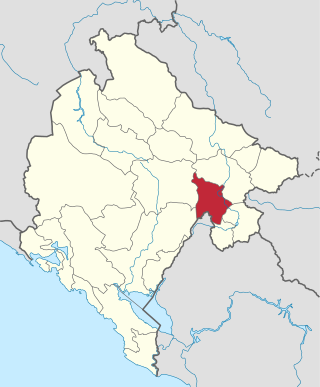
The Karađorđević dynasty or House of Karađorđević is the name of the deposed Serbian and former Yugoslav royal family.

In Norse mythology Valhalla (;) is the anglicised name for Old Norse: Valhǫll. It is described as a majestic hall located in Asgard and presided over by the god Odin. Half of those who die in combat enter Valhalla, while the other half are chosen by the goddess Freyja to reside in Fólkvangr. The masses of those killed in combat along with various legendary Germanic heroes and kings, live in Valhalla until Ragnarök when they will march out of its many doors to fight in aid of Odin against the jötnar.

Victor Emmanuel III was King of Italy from 29 July 1900 until his abdication on 9 May 1946. He also reigned as Emperor of Ethiopia (1936–1941) and King of the Albanians (1939–1943). During his reign of nearly 46 years, which began after the assassination of his father Umberto I, the Kingdom of Italy became involved in two world wars. His reign also encompassed the birth, rise, and fall of Italian Fascism and its regime.

Diomedes or Diomede is a hero in Greek mythology, known for his participation in the Trojan War.
The early written records of the history of Montenegro begin with Illyria and its various kingdoms until the Roman Republic incorporated the region into the province of Illyricum after the Illyro-Roman Wars.

William Adams, better known in Japanese as Miura Anjin, was an English navigator who, in 1600, was the first Englishman to reach Japan in a ship called de Liefde under the leadership of Jacob Quaeckernaeck, the only surviving ship of a five-ship expedition launched by a Rotterdam East India company(which would later be amalgamated into the United East India Company, the VOC). Of the few survivors of the only ship that reached Japan, Adams and his second mate Jan Joosten were not allowed to leave the country while Jacob Quaeckernaeck and Melchior van Santvoort were permitted to go back to the Dutch Republic to invite them to trade.

Petar II Petrović-Njegoš, commonly referred to simply as Njegoš (Његош), was a Prince-Bishop (vladika) of Montenegro, poet and philosopher whose works are widely considered some of the most important in Montenegrin and Serbian literature.

Isa Boletini was an Albanian revolutionary commander and politician and rilindas from Kosovo.

Montenegrins are a South Slavic ethnic group that share a common Montenegrin culture, history, and language, identified with the country of Montenegro.

Nikola I Petrović-Njegoš was the last monarch of Montenegro from 1860 to 1918, reigning as prince from 1860 to 1910 and as the country's first and only king from 1910 to 1918.

Momir Bulatović was a Yugoslav and Montenegrin politician. He was the first President of the Republic of Montenegro from 1990 to 1998, after which he served as the Prime Minister of the Federal Republic of Yugoslavia from 1998 until 2000, when Slobodan Milošević was overthrown. He was a leader of the Montenegro's Democratic Party of Socialists from 1989 to 1997, when he split from DPS after a conflict with Milo Đukanović.

Peter I was the last king of Serbia, reigning from 15 June 1903 to 1 December 1918. On 1 December 1918, he became the first king of the Serbs, Croats and Slovenes, and he held that title until his death three years later. Since he was the king of Serbia during a period of great Serbian military success, he was remembered by the Serbian people as King Peter the Liberator, and also as Old King.

The Christmas Uprising, also known as the Christmas Rebellion, was a failed uprising in Montenegro led by the Greens in early January 1919. The military leader of the uprising was Krsto Popović and its political leader was Jovan Plamenac.

Svetozar Vukmanović - Tempo was a leading Montenegrin communist and member of the Central Committee of the League of Communists of Yugoslavia. During World War II he served on the Supreme Staff, went on missions to Bulgaria, Greece, and Albania, and became Josip Broz Tito's personal representative in the Socialist Republic of Macedonia. He held high positions in the postwar government, and was proclaimed a People's Hero of Yugoslavia.

Sava Petrović was the Metropolitan of Cetinje between 1735 and 1781, ruling what is known in historiography as the Prince-Bishopric of Montenegro; the polity in the hands of the Petrović-Njegoš dynasty. He succeeded his relative Danilo I as Metropolitan in 1735, having served as Danilo's coadjutor since the 1719, when he was consecrated by Serbian Patriarch Mojsije I.

Rožaje is a town in northeastern Montenegro.

Andrijevica Municipality is one of the municipalities of Montenegro. The center is the town of Andrijevica. Its territory is outspread on 340 km2 and it is surrounded by massives of mountains Komovi, Bjelasica and Accursed Mountains in northeastern Montenegro.

The Drina is a 346 km (215 mi) long Balkans river, which forms a large portion of the border between Bosnia and Herzegovina and Serbia. It is the longest tributary of the Sava River and the longest karst river in the Dinaric Alps which belongs to the Danube river watershed. Its name is derived from the Roman name of the river which in turn is derived from Greek.

Pavel Apollonovich Rovinsky was Russian historian, Slavist, ethnologist and geographer.

Radomir Vešović was a Montenegrin and Yugoslav military officer and politician. Vešović was born in village of Lopate in Montenegrin county of Lijeva Rijeka, in a family whose male members were traditionally military officers. He completed military education in Italy in 1890 as the first member of Vasojevići tribe who received formal military education. In 1911 he was appointed as commander of Vasojević brigade, with rank of brigadier.



















